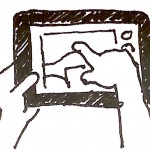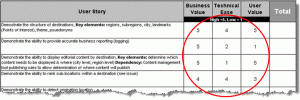
ADAM POLANSKY
Those bastards! Why can’t they see that a great user experience IS good business? How frustrating is it to be able to see project and product quality sidelined because you can’t translate the value into an algorithm that can predict success in decimal points?
What if I told you those bastards aren’t working against you? They’re simply working for something else. There are reasons for that; not good reasons but if you understand them, you have an advantage. What if I told you there are ways to create impact that you can put into play without asking anyone?
We’ll talk a little about why your enemy isn’t your enemy. We’ll also talk about specific things you can do to position yourself and UX to make an impact. They’re a little clandestine. They’re a little sneaky.
Best of all…you don’t need permission.
HERE’S THE TRANSCRIPT
Adam: When I was a kid there was always the kid that draws and I was one of them and my father having been in marketing and advertising all the time I was growing up I was surrounded by those people and so I had for as long as I can remember a sense of the business of design. And about the time when I was still in high school my father got me an introduction to a guy who had a small agency and that’s kind of an interesting story of itself in that he had been the art photography director for the Dallas Morning News in the 1950’s and 60’s, he had been the Creative Director for the Zales Corporation and he always wanted to teach and he had a teaching degree but he didn’t like the traditional classroom and so his way to teach was to open a small agency and find knuckleheads like me to teach the business and what this amounted to was learning how to do production ready art, photography – black and white and color, typesetting which goes all the way back to, if anybody hears this who knows what a big blue compugraphic monster, that’s what I learned how to set type on, line drawings. And so my desk was an art board at 30 degrees with the T-square.
One of the things I discovered though along the way was that my hands skills were obviously good enough to get a job, it seemed like everyone’s work I felt like their than mine. But I also discovered that I could do a better job communicating the concept of an ad or the concept of a campaign and working with another designer things came out the other end looking more the way I envisioned or better than I had envisioned if I had done them myself.
So it would be many years before I would realized the significance of that but I’ve had a fairly long and checkered career in everything from being in the military, professional services (which is a nice way of saying “putting in toilets”), working in restaurants, in sales, in printing, in production work, sales service in business forms, printing, and so I kept coming back to that but no matter what I did or where I was I always seemed to find myself in this position of liaison.
There are some people who have big ideas about something that they want to do and there are some people who build the stuff and there is somebody who sits in the middle and somebody who translates that and somebody who can speak more than one language in this case. And whether it was my job officially or not, that is what I always wound up doing. I always seemed to gravitate toward that position and there always seemed to be a need for it and either I would step up or somebody would say “Go get Adam!” “We’re not quite sure what he does but he’s handy at this kind of stuff with these circumstances.”
Coming out of the military I went back into printing, I was in newsprint for a while and decided at one point to go back to school. One of the things I had done when I first was going to college finishing a degree in design this time around, 15 years later, I had worked for enough small companies and I had seen what happens to entrepreneurships when the people running them don’t have a very good sense of business.
They are very good at what they do – they are craftsmen, technicians, but they either don’t surround themselves with the right people or they just don’t have the right people there to manage the business part of running an operation. And so I thought no matter what I do I need to have a better handle on that so I went back to school and I finished a bachelor of science in business administration and picked up another degree along the way with that.
About that time there was the rise of these small internet agencies, these little boutiques, guys on cafeteria tables in various places. I was introduced to a guy and I carried his card around for about a year and a half because at the time I was really focused on finishing my degrees. There were no summers off, I was carrying more than a full load [of classes] most of the time and working full time at night with my wife supporting me while that was going on.
Lara: That was nice of her.
Adam: Yeah, I hope she feels like she got the pay off.
I went to talk to this guy in this small group and he got up on a whiteboard and drew sort of the way they operated – their process if you want to call it that. He asked “Where do you fit?” and I said “Well, there’s guys up there selling stuff and guys here thinking big thoughts and guys down here building it. I live right here in the middle, I don’t know what you call that and neither did he, but this was my first interview and I thought this was just to kinda get used to the sound of my voice. I really wasn’t looking for anything to happen there.
He said “Well call me tomorrow for what you think is an acceptable package.” I had no clue. What qualified me up to this point was that I could surf the internet from home and that was about it. I really didn’t have a keen understanding of what was going on yet with this industry. So I called my brother-in-law down in Austin who was a well-established geek and said “What do you ask for something like this?” And he gave me a number and I came back and gave him the number and he beat the number – so I had a job!
Lara: What was the title?
Adam: There wasn’t one. We had none because they weren’t very stylish at the time. That group was later absorbed and merged and grew into one of the bigger agencies during the time when everyone was trying to set themselves up like an Anderson consulting with secret sauce.
You had these agencies that grew at obscene rates with offices all around the world and then in 2001 everything turned sideways and that was the end of that. And in this particular case the company was being run by a guy who was running it as a financial play. The blush was off that rose and that was the end of that story.
Like a lot of folks I found myself with some spare time. During that period, what happened was I spent the first two years not having any title, I was just this handy guy to have around and I did everything from managing the books and payroll and facilities to what we would later come to call information architecture. We just didn’t have a name for it. In advertising I was just doing the things that I did to conceptualize the beginning of a campaign.
There was a lot of sketching involved and I would translate things into digital formats just to make them a little clearer. They were for all intensive purposes wireframes. I would [design] a lot of sitemaps for these websites and came up with stylized versions of those and those became very popular. All the clients wanted sitemaps after they saw the first one. They looked good on the wall. They were fictional after about 10 minutes but they looked good.
Lara: So it sounds like you were able to understand the business goals that they wanted to achieve but you also could speak the [development] language and help everyone understand what you needed to achieve.
Adam: Not so much the dev language and even today I don’t speak a lot of that but what I have is at least the sense to take a very raw concept and get with the guys who do understand it and who do speak that and vet what I’m doing with them to make sure I’m not painting them into a corner or I’m not inventing something that either can’t happen, isn’t going to happen or is outside the reach of whoever is going to build the thing. Sometimes it will be a really cool new idea and the developers will look at that and scratch their chins a bit and say “You know there isn’t anything quite like it but I think I have an idea about how to make that happen.” And that’s when the magic starts.
So it wasn’t as much of speaking their language as it was being courteous.
Lara: That’s important.
Adam: And checking with them and walking them through these ideas and including them in that conversation because ultimately whatever it is I could get a client to commit to they were on the hook to build. It wasn’t so much about thinking about process as it was just covering my ass to make sure I didn’t make impossible work for someone else. Just be nice.
Lara: It’s really great when they can say we can do that but we want to tweak it and this way is going to be better.
Adam: Right, and being open to those changes. Plus these days a lot of these guys have built enough of this stuff that they begin to have an interesting sense of their own of something that might be useful and that’s true for the designers and that’s true for a lot of folks on the business side as well. I think today probably that space, which sees the most conflict, is still between user experience and business and it can be technology as well. It really depends on their perspectives and what’s driving them and any number of things that set up the way that they’re accountable. Mileage will vary. There are not sweeping statements you can make but they do fall into persona is another way to put it, a nice way of saying generalizing.
Lara: You have such an impressive career with American Express, Travelocity, Dr. Pepper. What were some of the biggest “Ah-ha’s” that you took away from that experience?
Adam: When you are working with large enterprise environments it can be very soul eating because you have a lot of the same politics and a lot of the same stuff that goes on in large companies. Large conflicts play themselves out in some of these environments and their agendas are not visible to everybody.
It was during that time that I was doing work for Radio City Entertainment and in this particular case Radio City Entertainment was a fairly small entity. They didn’t have a lot of money, however they were owned by Cable Vision which was a family owned operation which owns many sports teams and retail and main cable provider in the northeast and so there was a bigger prize if we could do well with this one.
This client needed a website and they had two goals and they were very clear. One was a marketing goal, which is differentiating Radio City Entertainment from Radio City Music Hall. Now, they owned that venue and they also owned the theater at Madison Square Garden but they were a production company and so they would produce stuff that would happen all over the country and in various venues as well. So you hear Radio City and everyone would think of the venue and not think of the production company. They wanted to create the beginning of a distinction there.
And they had a business goal, which was simple. Get them on the website, show them the calendar, get them to click through to Ticketmaster and buy tickets to events. Done.
We went up to New York and mapped out a site and went through a bit of an issue because we had a new creative director who had joined our agency who came from a very high-end retailer. Whatever they did was the gold standard and the bigger issue was that this was a time when nobody really knew where all this was going and what we were going to do with it. The cool thing about that was that everybody felt like they had a lot to learn. This person, not so much.
The first sit down with the client went really well, we got a lot of work done. The second time she joined us and threw a whole bunch of things on the table that just were not even remotely feasible, possible, affordable. It was really kind of all over the place and all based on the standards set at this retailer.
Well this was my boss so I couldn’t really tell her she was an idiot. I also had a client that was looking to me with answers because they weren’t just going to call her an idiot either. So I came up with a way to qualify features and functions within an application. It’s not unlike what a lot of people still do in projects when you get everyone in a room and you say, “Okay, let’s rate this stuff”. If you’re playing the agile game – playing agile poker and coming up with scores essentially to grade or weight stories and my way of doing this was to take every function and feature in this app – because they are all listed out we had this inventory, but there were a bunch of ideas that weren’t really going to go anywhere.
The best example was the interactive Rockette Paper Doll. It didn’t do anything to distinguish the client from the venue, it actually went the opposite direction. This was also a time when Flash was in its infancy. Web apps that allowed you to [design] drag-n-drop were still kind of new and the people that knew how to do that weren’t cheap so this was way out of the ballpark for us but I couldn’t just say, “That’s stupid.”
 Lara: And what was the purpose of that and was it achieving your goals and the answer obviously was no.
Lara: And what was the purpose of that and was it achieving your goals and the answer obviously was no.
Adam: But she wasn’t hearing that. So when we went through the grading process what I did was I took each feature and I asked the people on the product side to give it a grade. And I wanted them to be very specific. I only wanted them to worry about whether or not this is a feature that will make or save money. And then I asked the development guys to give a rating; their own rating based on how hard or easy it was to do. There are your two agile things right there, business risk and ease of implementation.
I also sectioned out another set for user value. What will a person make of this; Will make for a good experience or not. I asked people to really put on the blinders and so that did a few things.
I asked people to really put on the blinders and so that did a few things.
It kept people from badgering folks in other groups to come around to their way of thinking about a particular feature or function.
It kept it out of the control of the person in the room with the most power. Now that doesn’t mean they still couldn’t just trump everybody because they have that capability but it’s a little harder in daylight with everyone there when everyone else is in earnest and playing the game the way it ought to go. If you are trying to trump everyone in that space you are really kind of being a deliberate asshole. Most people are not assholes deliberately.
Lara: Was this anonymous or in a group setting?
Adam: It was in a group setting. What I did, and this was the connection point, we were talking about users and technology and business ownership. I made a connection between those three things and time, cost and quality, the three constraints you have in every project. And so people will say you get 2. That’s a lie. You get 1. Because you will break a tie if you try to select 2 at any level you’re going to break the tie between them, something will happen.
What I figured out was that cost was mostly the business ownership, time was mostly the province of technology and in some cases they were interchangeable. But at least within that context and quality was mostly within the province of user experience. These aren’t clean hard lines but they’re close enough.
So we would do another exercise, kind of like I described before where you try to figure out time, cost and quality. Which of those thinks has the least amount of flexibility. That one is usually obvious. If there is a hard date that something needs to be done, that just is in the driver’s seat now. That means between cost and quality, in a fight, which one will win?
So quality means that there are functions in this application or capabilities in this application that absolutely must be there no matter what or there is no point in doing it. From a cost standpoint, it’s “We run out of money here.”
Lara: That’s pretty obvious.
Adam: In this particular case it was cost because there was a set amount of money and what they didn’t know was that in order to get the bigger piece of the business we were willing to absorb a little bit so there was a little bit of a buffer there that we weren’t letting them in on. By doing that, I could then take the fact that I knew one of those areas between the three and had no flexibility in it, I could take all the scores in that column and weight them, in this case it was by 3. And the next one down the line those scores were weighted by 2 and the last one all by 1. What I got was one number for each of those features and functions and I sorted them on that number and I’ve been doing this now for about 9 years and somehow magically there is almost always a perfect demarcation line that shows either where the money runs out or time is up. Everything above the line is a complete solution and everything below the line is either a variation of a theme or something that has no business being there in the first place such as…the Rocket Paper Doll.
And so without my having to point fingers or anything, you can see the degree with which I went to cover my ass and to keep from saying “That’s stupid.”
Lara: Well, it served you well obviously because it’s a great process.
Adam: And so the paper doll ends up at the bottom of the list and it was done by consensus and nobody had to tell anyone else that they were being idiotic. It just wound up there on it’s own. Oh gosh, isn’t that a shame?
Lara: The paper doll was good because it instigated the whole process.
Adam: Yes, I’ve gotten a lot of traction out of that.
Lara: It was good and bad.
Adam: I’ve gotten more mileage out of that exercise since it published in a couple different venues like boxes and arrows and a textbook that if you were an unfortunate college student about 5-6 years ago in the UK you might have read it. I’m not even sure it’s in print anymore.
 It’s still something that I use in one way, shape or form. It’s about using extreme bias to get an unbiased scope because you’re not letting the characters drive what the constraints are you’re letting the overarching constraints that everyone has already agreed upon drive what gets more emphasis and less emphasis. That was probably the biggest thing that came out of that period at least for me. I still dust it off I have a picture of it.
It’s still something that I use in one way, shape or form. It’s about using extreme bias to get an unbiased scope because you’re not letting the characters drive what the constraints are you’re letting the overarching constraints that everyone has already agreed upon drive what gets more emphasis and less emphasis. That was probably the biggest thing that came out of that period at least for me. I still dust it off I have a picture of it.
Lara: I’d like to see it.
Adam: It’s in a presentation.
Lara: For your talk here at the IA Summit I know you are talking about creating impact without permission so maybe you could talk a little about that.
Adam: Sure. As we were saying before there is often an impasse between what a business feels like they need to do for the health of their business and what people in the user experience space would expect to see or would want to be able to do in order to make that business be successful.
There are a lot of things that have contributed to this and crystalized even since I originally put this presentation together. Part of it had to do with coming out of a place where I was the User Experience Director at Travelocity and I had been there for about 8 years and for all intensive purposes we reached a point where we were mostly rearranging furniture.
The checkout path for purchasing a hotel or a flight is pretty much what it is and you’re just trying to squeeze every last conversion dollar out of the process that you can, knowing that 25-30 other folks end up doing almost exactly the same thing.
When I left Travelocity I had a period of time where I could be a little leisurely in my job search and I had the chance to go on several interviews. Having conversations with businesses particularly the ad agencies seemed to stick out the most as the ones that frightened me the most and that I was hearing things like “Yes, we need user experience, we need to get that in here and we want you to come in and setup this whole practice,” and I would ask questions like:
- Do your line of business owners share this vision?
- Product directors?
- Account Managers?
- Creative Directors?
Lara: The team.
Adam: Yeah, but certainly the people within these companies who have the most leverage. And I would hear “Well, not really, we kind of expect you to help build that up.” My response was the same, it became almost a litany to the point that I would say “I want 2 things. I want corporate mandate and executive air cover.” I need the whole company to know that this is going to be important and it’s not going to easily be kicked to the curb when other pressures and pains come to bear and they will. I need to have executive air cover so if the argument goes above my head on paper so to speak that I need to know that there is somebody coming in behind me who can level it back off again.
There was great reluctance to offer those things and I began to get a little discouraged.
Lara: Do you think it’s because they didn’t understand the value of the role?
Adam: I don’t think it has to do with roles. I think it had to do more with how certain people grade success and this goes back to a story that I like to tell that really only happened a few years ago.
Working as an artist and a designer, you show people your stuff and whenever I would show things from my portfolio one of the things I noticed over the years was that if people looking at it had any idea at all about creativity they would ask questions about inspiration or the medium that I chose or something along those lines.
If they didn’t have an idea about creativity or design I would get the exact same question every single time which was “How long did that take?” That used to really piss me off and I would sit there and just say, “This schmuck doesn’t get it.” That’s kind of what happens in user experience space.
People, who don’t understand it, marginalize it and the user experience people feel ill used and they sit on the curb and grumble and moan about how they just don’t get it. And I realized something coming out the other end of some business degrees. I realized that it’s not that they don’t get it, they don’t. But when faced with having to appraise something that they don’t necessarily understand, they want to say something nice and so they want to translate it into something that they think must have value, which is time. It’s a piece of artwork and I’m not doing anything with it and I’m not trying to sell it. It doesn’t do any good to ask me how much that costs although I did get that question sometimes which was nice. Mostly that left, “well if it took a lot of time then it must be good.”
When I realized all that was really going on was somebody was just trying to be nice and trying to say something that put value in a context that they could understand I could stop being mad at all these people for how ever many years. They were just trying to be nice.
So the idea with this presentation initially was to speak to two audiences – to talk to business people in this case it’s a UX crowd, about how to get the best out of user experience and a user experience team. They know what they want from it. They have examples out there and they want these outcomes but they aren’t willing to put the same things into the effort to get those outcomes.
Apple stands out as one of the best examples but there are other companies as well who have protected design. On the UX side it’s talking to the UX professionals to say “Look, here’s what’s going on with these guys.” They didn’t get up this morning and decide to be jerks. Here’s what’s driving them, here’s what they are accountable for. They are going to be standing in front of somebody once maybe twice a year to explain why their predictions for the success of the company did or didn’t work.
That’s why when they come to you and say “Well, before you can do this Mr. UX person or Mrs. UX person, I need an estimation of exactly how this is going to work and I need to know bit by bit how it’s going to go.” Of course that’s fiction about 10 minutes in but it’s because their world makes sense when it can be turned into an algorithm and it’s the feeling that you have to demand an algorithm out of design that causes a disconnect. So that leaves us trying to say “Well, but we know intuitively that good user experience is going to be good for business but we can’t prove how, we can’t show it in decimal points. It’s because it’s not an A + B = C equation. It’s A + a few other things = E or F and that sort of opaque veil over the things that happen in between that people are uncomfortable with.
One of my favorite quotes is from Hitchhikers Guide to the Galaxy [by Douglas Adams]. Just as we’re about to get the ultimate question to the ultimate answer of Life the Universe and Everything, The philosopher’s guild busts in and their chief demand is that “We demand rigidly defined areas of doubt and uncertainty.” I love that idea. When I’m talking about process I can say to a product owner that here are these gateways that I know we need to cross but you’re going to have to leave me alone in between those gateways. We are going to have to demonstrate here by how I get there. You’re going to have to let me go with that one because I don’t know.
We talk about reactive design and there are other new buzzwords that make you compliant these days but to me that has always been about what we do – we assess and we adjust but we have to be given the opportunity to assess and then make a plan and then adjust to that plan. Or if we are already downstream on something to re-assess and adjust to that managing peoples expectations. That has always been at the core of working a project. It’s when we try to script the whole thing out in advance and expect that activity to equal a particular number that we’ve already predicted as well we are going to be disappointed.
If we can get people in this is going to come straight from any number of other folks talking about the same thing whether you talk to Jeff Gothelf about Lean UX design or you talk to Jeff Parks about the [Follow the UX Leader] workshops he’s doing it’s about focusing on outcomes. This is the thing you want to have happen. This is what “there” looks like so we will know when we are there. If you give me enough latitude to figure out how to get there and communicate to you that we can get there and not bug me about all the little things in between you’re going to be pretty happy with the outcome. Otherwise, what we are going to be doing is we are going to be arguing a lot when things don’t exactly fall into place with this script that we tried to predict.
 There is a saying in the military that no strategy ever survives its first encounter with the enemy. I would like to get away from the whole adversarial thing there but it is ultimately going to boil down to as I said before. It’s good manners and it’s also trust. And trust is a big chunk of about what I will talk about today too.
There is a saying in the military that no strategy ever survives its first encounter with the enemy. I would like to get away from the whole adversarial thing there but it is ultimately going to boil down to as I said before. It’s good manners and it’s also trust. And trust is a big chunk of about what I will talk about today too.
You kind of can help yourself by doing a little audit.
- How well are you trusted and by whom?
- Are you trusted by the right people?
- How can you influence that?
Sometimes your credentials will get you trust walking in the door and it’s your to lose. Other times you might have to dig your way out of a hole that someone else dug and it’s not even your fault – someone that’s not even with the company anymore has put you in a bad spot and now you have to bail it out. Whether you’ve earned [trust] or keep it you still have to get it and that’s what you’re going to have to trade on because pain comes from bad quality or running out of time or running out of money. The time and the money make themselves felt a lot earlier and when that’s the case the horizon for quality is usually further out here and usually that’s why it becomes so easy to marginalize the user experience part of things. It’s not because anyone wants a bad product. It’s not because anyone wants a bad quality. It’s just because from the standpoint of putting out fires and accountability they are going to have to answer to the money. They are going to have to answer to the time immediately and so they start to micromanage and get involved and start doing things to demonstrate to other people who aren’t involved everyday how things are going. That’s where things start dying. At some point you start casting off sandbags and the user experience part can look like a sand bag when you’re in that circumstance.
 Lara: I found that at the beginning of a project is the most challenging because you do have to overcome the time and cost constraints but if you are able to start where you want to end up by presenting what you can achieve and get their buy in at the beginning, then if you have issues during the design and development the executives are a little more flexible because they still want to show the good product at the end where they can say “Look what I did!”
Lara: I found that at the beginning of a project is the most challenging because you do have to overcome the time and cost constraints but if you are able to start where you want to end up by presenting what you can achieve and get their buy in at the beginning, then if you have issues during the design and development the executives are a little more flexible because they still want to show the good product at the end where they can say “Look what I did!”
Adam: It sounds a little silly but they have to have a little faith which is another way of saying they have to trust you. They have to hopefully engender that in the people who are looking to them for answers as well – their bosses whether it’s a Board of Directors or an executive group.
The rest of the presentation I go through about 5 different measures that an individual UX practitioner can take essentially by working in the periphery. So rather than going and asking “Can I do this, that, or the other, just do it! It may mean working in your off hours, it may mean working nights and weekends to get this done. If you simply go and do the thing and you come forward with the results and the outcome and you give them a taste and say “Isn’t this great to have this input and to have this informing what we are doing?” We could be doing more of this. These are things that have been the usual suspects for the user experience community for a long time. You could do a heuristic analysis – one person can do that. It’s basically an expert review and there are enough sets of good guidelines out there so that when you come forward with those responses it is essentially your opinion but it’s a set of guidelines that are generally accepted and so it’s not just me saying “Here, we should do this because I’m smart and I say so.” It’s saying that these are some rules most people follow.
Do remote usability testing. Most of the websites out there that offer that usually offer a little freebie period so you get a demo period where you could put together a little prototype that is clickable wireframes or something like that. You could run it past about 10 people and it’s not going to give you something very definitive but it’s going to give you something indicative where I ran this by 10 people and 6 of them said…this. That probably deserves a longer look.
Prototype something. Whether it’s using Axure or Balsamiq or any of the new tools they have out there that are web-based or device based for mobile apps. Build something that sings and dances a little bit. Stick that in someone’s hands or let them do it and they get it.
The first time I did a prototype using Axure it was really an inelegant thing. It was ugly but it covered a lot of complex thinking and there was a lot of complex interactions there and it was difficult to do because I really had to keep it straight in my mind all of the bits and pieces I had going on there and the sequence in which I needed to show them because it really was staged but I had to go into a review with our development team. This was about 6 guys most of whom I had known for a while and the project manager asked me “Should I schedule this for about 2 hours?” I said “You better make it 3, these things are usually pretty painful.” 30 minutes later we were done!
They got it.
They went back and had me dig into a few places but they thought that was the greatest thing since slicebread. They totally understood it and it was just because I didn’t have to sit there and hold up different pieces of paper and describe in abstract how I thought things would work or reach for the right piece of paper and say “Now it would look like this and now it would look like that.” I could just show them.
That speaks to the same value that’s being promoted by the guys who were saying do all your prototypes in html5 or [Adobe] Illustrator or in this tool or that tool. The answer to all of them is YES! Use the tool that makes the most sense to you that helps you create a level of understanding.
A few years back we had Richard Saul Wurman out here at the [2010] IA Summit in Phoenix. He talked about a lot of things. One of the nuggets that he dropped out there that I really latched onto was that an IA’s job is to create understanding. We get really enamored with our deliverables, how great our wireframes or the prototypes we are building. They are only great if they create understanding. If you use a little economy in your thinking so you didn’t go overboard and kill a lot of unnecessary time. If I can get an idea across by doing hand gestures and making animal sounds I have done the wireframe.
The people who are saying this is the best way or the only way – don’t listen to any of that. Whatever way works best for you and if you have a client who is just still not getting it and the needs have you just outstripped your own skill set then find someone to help. Find out what that level is where understanding clicks over. It can happen really early and a lot of people don’t even try they are more likely to go off into much more complicated things. It may hedge their bets but it also sometimes paints them into a deeper corner.
Lara: You talked about heuristic reviews, remote user testing, prototyping, what are the other two measures?
Adam: Gorilla user testing which is something Russ Unger talks about quite a bit. It’s another variation of getting prototypes together. Getting out to the coffee shop or something like that. The fifth one will be in the presentation.
Lara: The thing about creating impact without permission you’re saying just go ahead and do these things and that will help to get you the buy-in.
Adam: Yeah, they are relatively small exercises, they can happen fairly quickly and so you have a couple things going for you when you come back. First of all, you’ve accounted for your time so you haven’t been screwing around while all of this is going on. And you’re also saying “Here’s something of use of value.” The key is to take these things. Some of them will stand up just as they are. “They are neat, they are cool – I get it!” says the boss. You may need to take it a little further and put it in the context of those things that they’re understanding – what they see as a burn-down rate, what they see money evaporating, when they see the time going away or they are becoming concerned about what the final product is going to look like because they feel they have to cut the corners and sacrifice. In any of those circumstances you have to choose wisely which of these methods you are going to use and if you are going to combine them. But they have to suit the circumstance. You also need to come back and say here’s what this means to you in terms of money or time. We can save ourselves some time if we set a little aside now to do this otherwise we are going to keep going blind and we never have time to do it right but we always have time to do it over.
There is nobody in this business who hasn’t been through the pain of the late stages of a project that is in danger of missing its launch date and inevitably does.
MORE ABOUT ADAM
For a long time now, Adam Polansky has been closing the gap between ideas and reality. In a career that began in Advertising Design with few sharp turns along the way, and here’s what he shared with me about how he got started and what he learned along the way. his efforts contributed to successful projects across several industries for companies like Travelocity, Dr. Pepper, Radio City Entertainment, Texas Instruments, and American Express. He’s an active and established leader in the UX Community through organizations like the UXPA, The Information Architecture Institute, The IA Summit and Big (D)esign Events. A dedicated storyteller, lecturer and author, he speaks regularly at conferences, schools and workshops. His published work includes articles for the Journal of the American Society of Information Science & Technology, Boxes and Arrows, the Society of Technical Communication and the book User Experience Success Stories – How Organizations Improve by Making Easier-To-Use Software and Websites (Gower Publishing 2006). He is currently a UX Strategist with Bottle Rocket, one of the most successful mobile app agencies in the world.
T @adamtheia #BDUX #BrownDirtUX
FB http://www.facebook.com/AdamtheIA
LI http://www.linkedin.com/pub/adam-polansky/0/9b9/130/
Slideshare http://www.slideshare.net/AdamtheIA
Sketches provided by Adam Polansky
FACETED FEATURE ANALYSIS
Learn more about Faceted Feature Analysis from Adam Polansky on Boxes and Arrows.






1 Comment
Lara,
Congratulations on being up and running! Well done. Thanks for the informative interview.